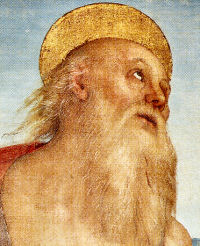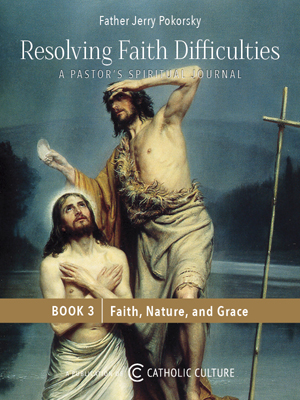Ordinary Time: September 30th
Memorial of St. Jerome, Priest and Doctor of the Church
Other Commemorations: St. Francis Borgia, Priest (RM)
» Enjoy our Liturgical Seasons series of e-books!
Today is the Memorial of St. Jerome (345-420). Jerome was born in Dalmatia of a Christian, was baptized in Rome, while taking his classical courses. He then studied under the best masters in foreign cities. But the Church had need of this extraordinarily gifted man. Jerome heard and obeyed the divine call, made a vow of celibacy, and withdrew for four years to a hermitage in the Syrian desert. The Holy Father soon summoned Jerome to Rome and entrusted him with the enormous task of revising the Latin Bible. This work, which took 30 years to complete, is the Vulgate version of the Scriptures. He also wrote many other works, mostly commentaries on the books of the Bible.
The Roman Martyrology also commemorates St. Francis Borgia (1510-1572), a descendant of the notorious Alexander VI. He spent a part of his life in collecting titles and offices of importance. Certain reverses of fortune caused him to reflect on his life. He was already a Franciscan tertiary, but this was not enough for him; he became a Jesuit, at first secretly and then publicly in 1550 having made provision for his eight children. In 1565 he became General of the Society of Jesus. He was a man of wide experience, a clever diplomat and ranks as the second founder of his Order. He died in Rome on October 1, 1572.
St. Jerome
 One of the greatest Biblical scholars of Christendom, Saint Jerome was born of Christian parents at Stridon in Dalmatia around the year 345. Educated at the local school, he then studied rhetoric in Rome for eight years, before returning to Aquilea to set up a community of ascetics. When that community broke up after three years Jerome went to the east. He met an old hermit named Malchus, who inspired the saint to live in a bare cell, dressed in sackcloth, studying the Scriptures.
One of the greatest Biblical scholars of Christendom, Saint Jerome was born of Christian parents at Stridon in Dalmatia around the year 345. Educated at the local school, he then studied rhetoric in Rome for eight years, before returning to Aquilea to set up a community of ascetics. When that community broke up after three years Jerome went to the east. He met an old hermit named Malchus, who inspired the saint to live in a bare cell, dressed in sackcloth, studying the Scriptures.
He learned Hebrew from a rabbi. Then he returned to Antioch and was reluctantly ordained priest. With his bishop he visited Constantinople and became friendly with Saints Gregory Nazianzen and Gregory of Nyssa. And then in 382 he went again to Rome, to become the personal secretary of Pope Damasus. Here he met his dearest friends, a wealthy woman called Paula, her daughter Eustochium and another wealthy woman named Marcella.
Here too he began his finest work. Commissioned by the pope, he began to revise the Latin version of the psalms and the New Testament, with immense care and scholarship. Jerome eventually translated the whole of the Bible into the Latin version which is known as the Vulgate. But when Damasus died, his enemies forced the saint to leave Rome.
Accompanied by Paula and Eustochium, Jerome went to Bethlehem. There he lived for thirty-four years till his death in 420, building a monastery over which he presided and a convent headed first by Paula and after her death by Eustochium. The saint set up a hospice for the countless pilgrims to that place. His scholarship, his polemics, his treatises and letters often provoked anger and always stimulated those who read them. 'Plato located the soul of man in the head,' he wrote, 'Christ located it in the heart.'
—Excerpted from A Calendar of Saints by James Bentley
Patronage: Archeologists; archivists; Bible scholars; librarians; libraries; schoolchildren; students; translators.
Symbols and Representaiton: cardinal‘s hat, often on the ground or behind him, indicating that he turned his back on the pomp of ecclesiastical life; lion, referring to the who befriended him after he pulled a thorn from the creature’s paw; man beating himself in the chest with a stone; aged monk in desert; aged monk with Bible; aged monk writing; old man with a lion; skull; hourglass
Highlights and Things to Do:
- Jerome had a violent temper and was very strong-willed. He made a lot of enemies because of his temperament. To overcome these faults, he prayed and did penance. His canonization shows us that canonized saints aren't perfect, but have faults just like us. They just worked on them and cooperated with grace more fully to overcome them. What faults do we have that we need to work more diligently on overcoming?
- St. Jerome was a wonderful spiritual director, especially for women. It is important to have a spiritual director to grow in the spiritual life. Find out what a director can do for you, and make some arrangements for one.
- The Bible was of utmost importance in Jerome's life and should be in ours. Make a point to read the Bible daily. Jerome was known to say that ignorance of Scriptures is ignorance of Christ.
- Catholic Culture Audiobook: St. Jerome—Against Helvidius: On the Perpetual Virginity of Maryby James Majewski
- Joos Van Cleve,
- Albrecht Dürer.
- Antonello da Messina
- Pieter Coecke van Aelst, the elder
- Vincenzo Catena
- Jan Van Eyck
- Domenico Ghirlandaio
For examples of St. Jerome and the Lion, see:
St. Francis Borgia
 Francis Borgia, viscount of Catalonia and third general of the Jesuits, was born in 1510. On his father's side he was a great-grandchild of Pope Alexander VI; on his mother's side he was the great-grandchild of a son of Ferdinand the Catholic. His holy life atoned for the sins of his ancestors.
Francis Borgia, viscount of Catalonia and third general of the Jesuits, was born in 1510. On his father's side he was a great-grandchild of Pope Alexander VI; on his mother's side he was the great-grandchild of a son of Ferdinand the Catholic. His holy life atoned for the sins of his ancestors.
As viscount and duke at the palace of Emperor Charles V, Francis stood in high honor. The sudden death of the beautiful Empress Isabella (May 1, 1539) and the sight of her disfigured face as her body was taken to Granada made him resolve to leave the world and serve the King of kings alone.
After the death of his wife (1546), he entered the Society of Jesus with the holy resolve of leading a hidden life and of closing the door forever to all earthly honors. His example of humility exercised an influence upon Charles V when he considered renouncing the throne. Devoted to labor and severe mortification, Francis held himself in such little esteem that he called himself the "poor sinner." In 1565 he became General of the Order. He died at Rome.
—Excerpted from The Church's Year of Grace, Pius Parsch
Patronage: Against earthquakes; Portugal; Rota; Marianas.
Symbols and Representation: Skull crowned with an emperor's diadem.
Highlights and Things to Do:
- Although Francis lived a holy life, he was deeply moved and changed his life even more profoundly after seeing the corpse of the young and once beautiful Empress Isabella — it was totally disfigured and unrecognizable. This made him realize the transcience of life and the worthlessness of riches. We should follow his example and meditate on this.
- Read more about St. Francis Borgia:
- Learn more about the infamous Borgia family tree.
- See the statue of St. Francis Borgia in St. Peter's Basilica Colonnade.








